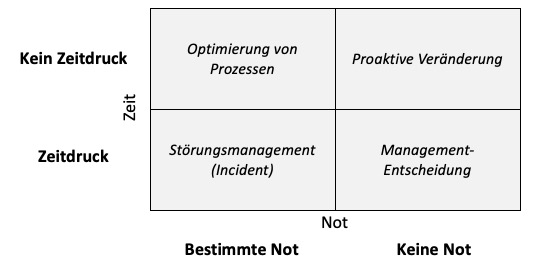“Where the wind of change blows, some walls and others build windmills” is a Chinese proverb. This article is aimed at everyone who is currently looking for a change in a company and / or who are also commissioned for this. In this article, I would like to deal primarily with the question of motivation for change and explain appropriate procedures to you depending on your motivation.
In the past few years I have often been to clients as a consultant and have advised on change projects. As a change agent, you can be quickly relieved of your position or burned in the company. It is therefore important to categorize the change correctly and to choose the appropriate procedure. I often experience change agents who approach a change full of emotion and passion. That is good, but a change should also be carried out according to a certain system and with a certain distance.
In the past, change managers have often asked me how certain changes can be implemented. For example, a change agent wanted to introduce Scrum without management support and without emergency. Unfortunately, it is obvious that it will not work. It is different with a company that wants to introduce Scrum due to customer pressure. I look closely at such a situation and plan how and how much effort I put into the change.

Four types of change
I believe that there are exactly four types of change in the company. These can be seen in the picture above. I differentiate between the time available and the need, i.e. the urgency of the change through, for example, Loss of sales. Depending on the type of change, you have to process and proceed differently for a change. See change management as a craft or profession. Unfortunately, I often experience change managers who lack fundamental theoretical foundations for change management.
Time pressure and a certain emergency: incident management
Incident Management comes from the ITIL textbook. An incident means that a reactive reaction to the disruption of an IT service is to be carried out. The IT team often solves the problem first with a quick solution.
It is the same for you as a change manager. bpsw. companies record losses during this time and cannot endure it for long or an important customer wants to terminate in 6 months if nothing changes. So you have great hardship and time pressure.
My advice: During this time you don’t have much potential for coaching or building self-organized networks. You have to present quick solutions and take the time pressure off so that you can do real organizational development. So stick to the classic approach in this phase and define quick and perhaps unsightly or unspectacular measures. As soon as the time pressure is out, you can develop the organization. However, the management first demands short-term solutions from you!
No time pressure and certain hardship: optimization of processes
In my opinion, this is the typical case in companies. For example: A company has a problem and employees complain about it and there have also been some layoffs.
So we want to strive for a change, but since we are economically in good shape, it is not important when it will be finished. You will get some problems because this change will usually take a long time.
My advice : Do not try to strive for direct short-term solutions, but gather strong support in management and communicate the need to the employees again and again. You should proceed slowly and iteratively: you have time! You can slowly build up a network and slowly change it a little bit, process by process.
In this phase you will not radically overturn anything or fully introduce Scurm. Rather, rush to optimize processes and wait until the need increases.
Reading tip: Change after Rogers and Prank
Time pressure and no particular hardship: management decision
The third case has often been my typical consultant case. The management would like something specific, for example the introduction of Scrum. However, there is no reason, it was decided by management and there is often a deadline.
My advice : You can use the pressure of management and should pay attention to compliance with the new processes rather than real organizational development. Actually, you actually carry out a process introduction and can then carry out organizational development as soon as the time pressure is over and management has considered Scrum, for example, to be introduced.
Reading tip: Change management according to Kotter
No time pressure and no particular need: Proactive change
The focus here is not on specific decisions, but rather on radical innovations or employee requests for, for example, a certain tool like Confluence instead of the old media wiki. The change is initiated by employees in the company with foresight.
You will notice that you usually have no support from management or any other help in this change. You won’t get any resources or anything else either. The change takes place in your overtime.
My tip: I see the only chance that you initiate the change with certain employees in the environment and show management through examples that it can advance the company. There is often a small chance that you will get away with this and care should be taken or you will get burned.
Conclusion
You notice that change management is still very classic and based on cause-action. Changes are rarely tackled without a cause and are often unsuccessful. As in my reading tips, it is always about linearly planned processes of change.
It is of no use to start the topic without prior knowledge and full of emotions, but rather to recognize the change with plan and skill and to do as much as possible. You can achieve more, for example, if you take the time pressure off with quick solutions and then build a meaningful organizational development on it, otherwise you will simply be relieved of the position beforehand.
At the end I would like to call for an open discussion on classic change methods and continuous change management!
[werbung] [fotolia]


